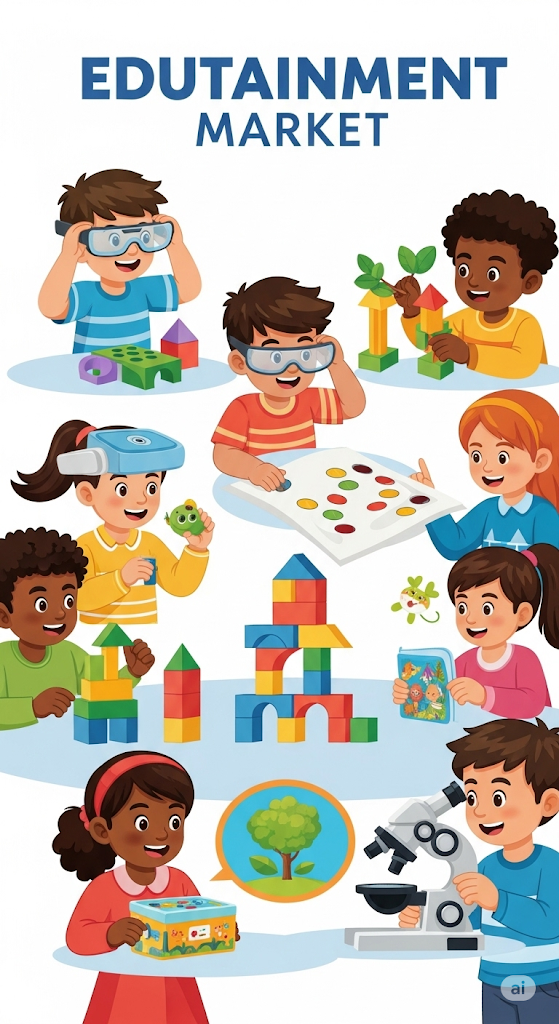A new industry assessment by Maximize Market Research reveals that the Edutainment Market—the fusion of education and entertainment designed to make learning immersive—will soar from USD 6.62 billion in 2023 to USD 19.60 billion by 2030, accelerating at an impressive CAGR of 16.77 percent. Fueled by interactive learning trends, rapid technology adoption, and significant venture investment in education tech, edutainment is redefining how children, teens and adults acquire knowledge.
Market Definition and Current Landscape
Edutainment encompasses interactive games, experiential learning venues, and digital platforms that merge pedagogical content with engaging storytelling, gamification and mixed‑reality experiences. From museum‑based discovery zones and indoor theme parks to mobile apps that teach coding through play, the sector’s reach now spans facility footprints under 5,000 sq. ft. to mega‑centres exceeding 40,000 sq. ft.. While entry fees and ticketing remain the primary revenue stream, ancillary sales—from branded merchandise to themed food and beverage—are growing rapidly.
Growth Drivers
-
Digital Transformation of Classrooms
Education ministries and private schools worldwide are pivoting to interactive, learner‑centric methodologies. Smartboards, AR overlays, VR field trips and AI‑powered assessment tools are becoming standard elements in modern curricula. -
Investment Momentum
Global ed‑tech funding surpassed USD 20 billion last year, a share of which is flowing to content studios and edutainment start‑ups developing hybrid physical‑digital experiences. -
Internet and Mobile Penetration
Affordable smartphones and high‑speed data plans—especially across Asia Pacific—are turning apps, streaming lessons and multiplayer educational games into everyday tools for self‑directed learning. -
Next‑Generation Technologies
Artificial intelligence tailors content difficulty to the learner; augmented and virtual reality create immersive simulations; Internet of Things (IoT) sensors transform physical play areas into data‑rich environments that adapt in real time.
Market Constraints
Lack of awareness in certain developing regions and limited access to state‑of‑the‑art hardware still restrain full adoption. Many institutions hesitate to upgrade due to cost concerns and a shortage of educators trained in experiential methods. However, fast‑evolving mobile technologies and cloud‑hosted platforms are steadily lowering adoption barriers.
Emerging Opportunity: Podcasting in Edutainment
Podcasting—recorded audio content downloadable for anytime learning—is gaining traction as a cost‑effective supplement to both online and face‑to‑face classes. Institutions that integrate podcasts into lesson plans report improved learner autonomy and free faculty bandwidth for more interactive, engaging classroom sessions.
Segment Insights
| Segment | Key Trend | Growth Implication |
|---|---|---|
| Gaming Type | Explorative & Hybrid models dominate, blending physical activity with digital overlays. | Drives higher repeat‑visit rates through constantly refreshed challenges. |
| Facility Size | 10,001–20,000 sq. ft. venues are proliferating in malls and urban mixed‑use developments, offering modular experiences. | Creates scalable franchise opportunities. |
| Revenue Source | Entry fees still contribute >60 percent, but merchandising and F&B are the fastest‑growing lines. | Supports diversified cash flow for operators. |
| Visitor Demographics | Children (0‑12) and Teenagers (13‑18) account for two‑thirds of visits, while family‑oriented attractions lift adult participation. | Encourages multigenerational design formats. |
Regional Highlights
Asia Pacific captured the highest market share in 2023 and is projected to maintain leadership through 2030. Smartphone ubiquity, large youth populations and aggressive government investments in digital literacy underpin regional momentum. China, India and Southeast Asian countries are rolling out smart classrooms at scale, while local edutainment developers partner with global tech firms to incorporate AI, AR and mixed‑reality into curricula and leisure venues. In contrast, North America and Europe continue to innovate in premium content and intellectual‑property‑driven experiences, setting benchmarks for safety, sustainability and accessibility.
Competitive Landscape
The industry features a blend of pioneering theme‑based operators and tech‑forward content creators:
-
Kidzania – Expanding franchise‑led “mini‑city” role‑play centers into Tier‑2 Asian cities.
-
Pororo Parks & Pororo Park – Leveraging popular animated IP to drive cross‑platform engagement.
-
LEGOLAND Discovery Center – Integrating STEM‑focused building challenges with digital gaming apps.
-
Meraas & Majid Al Futtaim – Developing mixed‑reality retail‑tainment hubs across the Middle East.
-
EON Reality Inc. – Providing turnkey VR/AR platforms for museums and vocational training institutes.
-
Jam Origin – Innovating music‑based learning games using AI‑powered instrument recognition.
Strategic alliances with technology providers, localized content development, and customizable franchise models are the dominant competitive strategies. Rising interest from private‑equity firms is also spurring consolidation, as operators seek scale and IP portfolios to stand out in a crowded market.
Outlook
As students, parents and educators demand more engaging, outcome‑driven learning, edutainment is bridging the gap between curriculum rigor and joyful exploration. With a forecast size of USD 19.6 billion by 2030, organizations that harness AI, AR/VR and podcast‑based micro‑learning will capture outsized value. Stakeholders that prioritize scalable franchising, strategic tech partnerships and diversified revenue streams are best positioned to lead the next wave of educational innovation.
Related Report:



